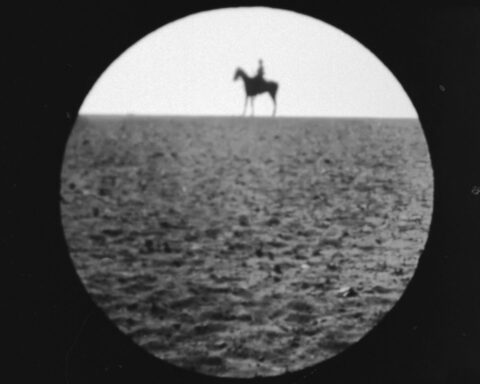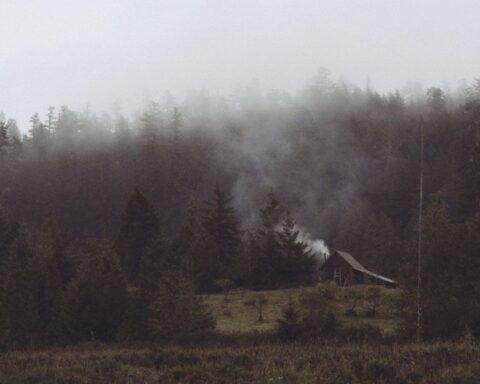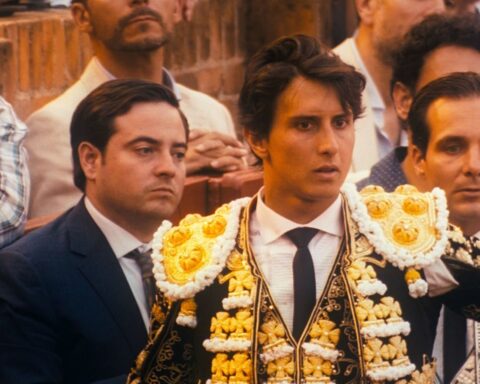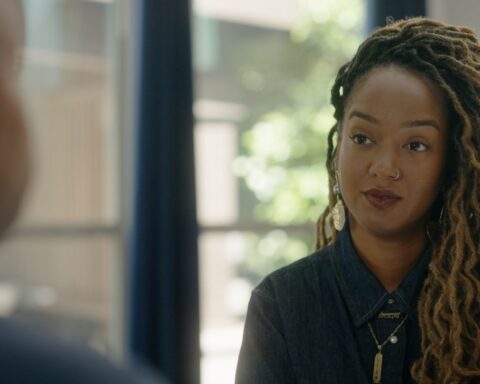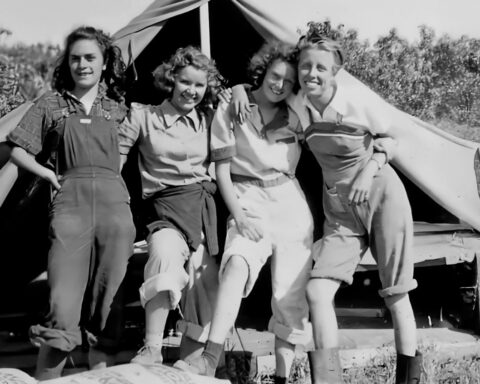One of the most powerful Canadian documentaries of recent years is The Patron Saints (2011), an exploration of an American nursing home that eschews a traditional structure in favour of a more observational approach. Its shots of aged and physically infirm residents either wandering the property or sitting in often involuntary repose are often held for a long duration via static camera set-ups, which helps to put across the theme of stasis. The film suggests a series of still-life portraits of people whose lives are slipping away. At a time when more and more commercially oriented documentaries seem to be privileging movement —of ideas, of camerawork or onscreen graphics— The Patron Saints feels like an intervention on behalf of a more contemplative mode of documentary cinema.
The directors of The Patron Saints, Brian M. Cassidy and Melanie Shatzky, have since gone on to international acclaim with their debut dramatic feature Francine, a low-budget character study starring Melissa Leo, which showed in 2012 at the Berlin International Film Festival. Shatzky is from Montreal, and the pair has retained a strong connection to the city’s filmmaking culture, which is why this fall, RIDM (Rencontres internationales du documentaire de Montréal) has invited them to curate a selection of films based around photographic images called A Photographer’s Eye.
It’s a choice that at once connects logically to the more portraitlike aspects of The Patron Saints and opens up pathways to some unique examples of non-fiction filmmaking. “We began by looking at films by photographers we admire and then expanded outward into larger ideas about what constitutes films made by those with a photographer’s eye,” said the directors in an email to POV. “We also felt it was important to include films that address what it means to capture a likeness.”
Cassidy and Shatzky began their careers as photographers, which further explains their attraction to work in this vein. They add that they were interested in seeing how “artists accustomed to working with stillness use time to create images,” and indeed, the difference between still and moving images has long been a favourite topic of scholars and artists. Cinema was born out of photography, and yet the two mediums come with their own set of formal and ideological concerns and contradictions, which have in turn been mutually affected by the advent of digital technology. The idea that film is “dead” animates a lot of discourse in the field of visual studies, but Cassidy and Shatzky are hardly traditionalists. “Because of digital media, there are infinitely more images being created than ever before,” they say. “This makes it difficult to sift through and find work that is worthwhile. But it’s certainly out there and living within new platforms—like, for example, Instagram, of which we are both fans.”
Perhaps no film illustrates the simultaneous intimacy and distance of the two disciplines like Chris Marker’s seminal science fiction “cine-roman” La jetée (1962), which uses still images to tell the story of a time traveller flung from a post-apocalyptic future into our present. Marker employs hundreds of precisely sequenced photographs to stand in for the frozen, fragmentary nature of remembering. The effect is not unlike a slideshow presentation, until, in the most famous moment, the director inserts 24 frames’ worth of celluloid into the assembly to suggest that his hero is no longer living in the past. The shot passes literally in the blink of an eye—it’s a close-up of a beautiful woman staring into the camera with sleepily lowered lids—and its effect is nearly subliminal, but once you’ve seen it, it stays in your mind forever. Marker used the still photography format again in his fleet, thoughtful 1966 travelogue Si j’avais quatre dromedaires (If I Had Four Dromedaries), which has been included in the programme. His spirit hovers over some of the more recent works, especially Jem Cohen’s Counting, which features an entire segment dedicated to the late New Wave figurehead. A self-styled essay film shot in a number of cities around the world over a period of a few years and featuring a soundtrack supervised by Patti Smith, Counting doesn’t feature much in the way of still photography—its aesthetics are strictly handheld and digital—but it is nevertheless attuned to stillness. Cassidy and Shatzky say that they were looking for works “that possess a photographer’s sensitivity to how images convey meaning,” and Counting is exemplary in this regard. Cohen can shoot a lone busker in such a way that he becomes an avatar of displaced artistry, or a tourist attraction in Russia so that it seems to comment on the ideological drift of an entire country. In that way, it reprises Marker’s classic doc feature Sans soleil, except that Cohen doesn’t use voice-over to express ideas about history, architecture and culture. Instead, he simply exercises a healthy curiosity about the world he moves through, and while it’s possible to mistake his impressionistic style for shapelessness, Counting finally demonstrates an impressive overall unity.
Considering its numerous urban interludes, an alternate title for Counting could be In the Street, and it’s likely that Cohen has seen the 1948 documentary of the same name by Janice Loeb, Helen Levitt and James Agee (the latter better known as the author of the Depression-era masterpiece Let Us Now Praise Famous Men with photographs by Walker Evans, and the screenwriter of Huston’s The African Queen). Shot in the mid-’40s in Spanish Harlem via concealed 16mm cameras, In the Street is hardly the first work of metropolitan ethnography, nor the first city symphony, a tradition that dates back to the silent era. But it’s still a seminal work, not least of all because it represented Levitt’s transition from still photography to cinema. During the Great Depression, “documentary photography” emerged as a potent form of journalism and social protest; the images produced by government-subsidized photographers like Walker Evans and Dorothea Lange of Americans living in squalor remain definitive in a way that even newsreels of the period could scarcely capture. By focusing primarily on younger subjects, Levitt and her collaborators were able to ameliorate some of the heaviness associated with studies of poverty, although if anything the excitement and innocence of the children being filmed puts the economic realities of their lives beyond the frame in even sharper relief. The locations are dilapidated, but the film is unmistakably and unapologetically beautiful; one can see the influence of its ragged, agile aesthetic on subsequent American independent landmarks from Kent MacKenzie’s The Exiles (1961) to Charles Burnett’s Killer of Sheep (1978), both of which at least partially bridge the gap between art cinema and vérité.
In the Street also connects closely to Khalik Allah’s Field Niggas, which showed earlier this year at the True/False Film Festival. In fact, it’s possible to see Allah’s hour-length film as an update of Levitt’s classic. Field Niggas takes in the faces of people who its director encounters on the street: residents and hangers-on, passers-by and police officers. It’s a wide gallery of types, and Allah has a great eye for the expansive landscapes that can exist between a pair of eyes or inside a gaping mouth. The twist is that every “interview” has been manipulated so that the soundtrack is out of sync with the image, which is sometimes slowed down. In lieu of talking heads, Allah provides us with a polyphonic, stream-of-consciousness narration that seems to belong to the entire community.
The tension here is between Allah’s indulgence of these marginalized subjects, whose stories are allowed to unfold at length, and his stealthy aestheticization of their lives into something that’s closer to installation art than vérité. Where Levitt sought to open a window on a closed-off community, Allah means to immerse and disorient the viewer, although the late interpolation of footage of the death of Eric Garner—the only scene to feature sync-sound—serves effectively to startle us back to full awareness. (The use of the Garner death as a structuring element links Field Niggas to Counting, which features footage of recent street protests in New York City.) Where Field Niggas, In the Street and Counting emanate from variably detached and borderline journalistic perspectives, Karsten Krause and Philip Widmann’s The Photographer’s Wife fairly tingles with intimacy. The photographer is Eugene Gerbert, a German railway clerk who left behind a massive collection of images of his wife, Gerti, ranging from the candid to the overtly erotic. Most of the 29-minute film is devoted to Gerbert’s snapshots, which surely speak to the man’s love and devotion but also something deeper. It’s hard to tell whether he was more compelled by his feelings for his wife or his need to obsessively document every inch of her body—and with it, a good percentage of their waking lives. At times, Krause and Widmann scroll through the photographs so that the screen becomes a kaleidoscopic collage, but mostly they let the shots linger, in between reflections from Gerti about her role as a life partner and muse. As a meditation on its subject’s chosen medium, The Photographer’s Wife is fascinating, but what’s really powerful is seeing how the human body can shape-shift so radically over a period of four decades without ever really changing. The imagery isn’t so much repetitive as revelatory. The protagonist of the long-suppressed French-Canadian short La femme image (1959) by Guy Borremans is also smitten with photographs of a woman; in this rarely seen Surrealist work, he ends up cavorting with her in the forest. A playful experimental work made in thrall of the young Look photographer and director Stanley Kubrick—certain shots closely recall Fear and Desire (1953) — La Femme Image is by no means a documentary, but it fits nicely within a group of films that meditate on the potential of still images. In Borremans’ lyrical vision, a slick magazine layout is the catalyst for an elaborate, immersive fantasy.
There are other striking films here, from Czech director Miroslav Janek’s The Unseen (1997), about the photographs produced by the young students of a school for the blind—a contradiction worthy of Werner Herzog—to Ulrich Seidl’s Animal Love (1996), an early work by the only Austrian filmmaker to rival Michael Haneke for critical acclaim and international distribution in the 21st century. Seidl’s dramatic features, like Dog Days (1994) and the Paradise trilogy, are distinguished by their formal rigour and deadpan misanthropy, although fans believe that his harshness is actually a form of humanism. The same goes for his documentaries, of which Animal Love is probably the best known; four years before Best in Show gently kidded the grotesquerie of pet owners, Seidl trained his camera on Viennese citizens clinging desperately to inter-species friendships. While some scenes could almost be outtakes from Christopher Guest’s comedy, the tone is generally dour, with the unhappiness of the humans juxtaposed against the seemingly related sadness of their animals (an aggressive couple is shown walking their dog and watching as its pent-up tension explodes in an attack on another, smaller dog). Animal Love isn’t a photo-documentary, but its relationship to portraiture is obvious. Whether Seidl is shooting his subjects with interest or exploitation in mind is a question worth asking. Cassidy and Shatzky are passionate about the films that they’ve selected, but for all the power these works derive from their engagement with the aesthetics and philosophy of photography, the programmers admit that they aren’t sure that any of them have a special or heightened veracity compared to traditional documentary filmmaking. “We are skeptical about claims that the photographic image represents factual truth, analogue or digital,” they say. “Photography is, by nature, a subjective process where one makes choices about what to include within the frame and what to leave out of it. These basic considerations imply that there is more to the surrounding circumstances than we could ever be privy to. As Garry Winogrand famously said: ‘Nothing is as mysterious as a fact clearly described.’




